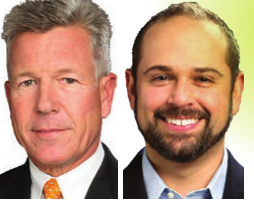Investors need to learn to curb their enthusiasm and set realistic goals
Investor expectations are outrageous.
And, no, we’re not singling anybody out in particular. We’re not upset about it. We’re just trying to reset some sights here. The expected return on investment in today’s market is out of control, and it’s time to take a hard look at what your own expectation really is — or, rather, what it ought to be.
We’re certainly not here to curb your enthusiasm. We’re excited about market highs as much as the next investor, but historically speaking, you cannot plan your financial future based on blips on the investment radar.
It’s a matter of financial survival. Remember when you were taking driver’s ed classes and the instructor had a brake pedal in the passenger seat?
We’re that instructor, and this is where we pump said brake.
We’re not trying to burst the bubble on the feel-good vibes of other-worldly investment growth, but we’ve got to reset the course and pay attention to the road for a moment here. We’re just saying, be careful. For every peak, there’s a valley.
If you’re banking on a 17.5 percent expected return on investment as the baseline of your financial future and you wind up with 4 to 5 percent, you’re doing yourself a serious disservice. You don’t need to be a mathematician to crunch those numbers. Planning on a double-digit ROI to bankroll the expenses you incur during retirement is not careful planning at all. In fact, it’s reckless. Your model needs to assume a lower rate of return than what you’re experiencing right now.
Why are expected return on investment numbers so skewed? It’s because of personal experience. Removing your personal bias from your investment strategy is going to help you realize more realistic goals and help you plan more concretely for your future.
Many investors are looking at the last 10 to 12 years and consider that the norm. Historically, it isn’t. If you were 42 years old following the 1970s, you assumed the market would perform quite poorly and planned for that. But if you talk to a 42-year-old in 2021, those who are coming into money, this generation’s common financial expectations are far rosier, and, if we’re being honest, dangerous. It’s possible that returns are consistent or exceed expectations here, but it’s not very likely, and it’s certainly not a promise.
In the United States, the top five concerns that could abate continued investment returns are:
• Volatility and valuations
• Tax increases
• Slow recovery
• Inflation
• Political dysfunction
These are very real, mindful concerns and thus help you better understand that, by assuming a lower overall expected return on investment, you can identify what you really need to save more concretely.
Set realistic goals, celebrate unexpected victories. Listen, we’re all investing in a long-term strategy right alongside our clients. We’re keeping our fingers crossed for another Roaring ‘20s here, just like the next investor. But, we’re here to tell you that you’d better not be depending on it. Again, if you’re planning on 17.5 percent and you get 5 percent to float the entirety of your model, you’re screwed. That’s just the way it is.
Following a major recession, everyone always puts their arms up in the air and says, “I didn’t see that coming …” When things get this rich and this distorted, nobody knows when the tipping point will be and when exactly it’s coming. Sometimes all it takes is a cigarette ash to burn a forest down. It’s drought-like, it’s fragile. Soak it up while the gettin’ is good, but be wary. That’s exactly where we’re at right now.
Curb your enthusiasm because everybody is hoping for a bolstered ROI, but set your expected return on investment on something you can truly work with. Bank on 5 percent, and if you wind up with 17.5 percent, we’ll pop a cork and celebrate right alongside you. Heck, we’ll bring the second bottle.
Tom Sedoric is partner, executive managing director and wealth manager and D. Casey Snyder is partner, senior vice president and wealth manager of The Sedoric Group of Steward Partners in Portsmouth. They can be reached at thesedoricgroup.com.